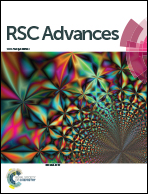Hollow Au–Ag bimetallic nanoparticles with high photothermal stability†
Abstract
Noble metal nanoparticles have received much attention due to their interesting properties that make them useful in different technical fields. Metallic nanoparticles with optical properties in the near infrared region of the electromagnetic spectrum are of great importance for biological applications, in particular photothermal therapy, as it is greatly enhanced by metallic nanoparticles. However, despite the large amount of work that has been done with metallic nanoparticles for thermal therapy, there is a reduced amount of scientific reports about the photothermal stability of most studied nanoparticles. In this work, hollow Au–Ag bimetallic nanoparticles were synthesized via galvanic replacement reaction, with optical properties that can be tuned systematically along the visible and near infrared region of the spectrum, by changing the pH before the synthesis of the templates and by controlling the amount of gold added for the synthesis of the nanoshells. The synthesized nanoparticles exhibit good photothermal properties when illuminated with an 808 nm laser light. An increase of temperature of nearly 20 °C is achieved after 15 minutes of irradiation. Moreover, the Au–Ag nanoparticles show good reusability even after ten heating/cooling cycles. The nanoparticles also retain their optical properties after 12 hours of continuous irradiation and are able to maintain their photothermal characteristics of increasing the temperature at the same levels during the entire process.



 Please wait while we load your content...
Please wait while we load your content...